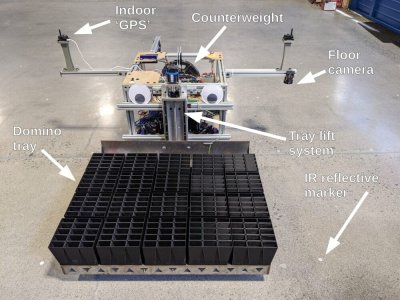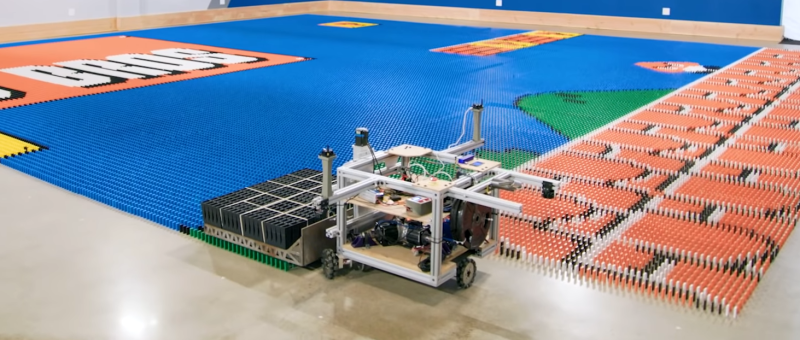Creating large domino art displays is a long and nerve-racking process, where bumping a single domino can mean starting from scratch. To automate the process of creating these displays, a team consisting of [Mark Rober], [John Luke], [Josh], and [Alex Baucom] built the Dominator, a robot capable of laying 100 000 dominos just over 24 hours. Video after the break.

[Mark Rober] had been toying with the idea for a few years, and the project finally for off the ground after [Mark] mentioned it in a talk he gave at the 2019 Bay Area Maker Faire. To pull it off, the team created an entire domino laying system, including an automated loading station, a precision indoor positioning system, and the robot itself. The robot is built around a frame of aluminum extrusions, riding on three omnidirectional wheels driven by precision servo motors. A large tray mounted to the front of the robot can hold and release 300 dominos at a time. The primary controller is a Raspberry Pi 4, which receives positioning information from a Marvelmind indoor positioning system and a downward-facing IR camera that looks for reflective markers on the floor. The loading system uses a conveyor system to feed the different colored dominos to an industrial Kuka robot that drops them down a grid of tubes that can hold multiple layers at once.
[John Luke] and [Josh] built the mechanics, while [Alex] handled the electronics and software. [Alex] also wrote an excellent series of posts (linked above) detailing the development process, hardware, control system, software architecture, and trajectory generation. He also released all the code on GitHub.
[Mark Rober] is well known on YouTube for collaborating on ambitious projects like the auto-bullseye dartboard, glitter bombs targeting package thieves, and the guided bowling ball.















This is awesome!
Ahh that’s why they banned plastic straws in the EU so they can do this :D
It’s projects like these that eventually morph into larger scale projects like completely automating a shipping warehouse (think Amazon). Lots of real world use cases for the technology. Kudos to them!
Yea it’s very nifty and clever but I cringe at the amount of plastic and that the image was just an advertisement for a computer game.
Collaborating with an artist to lay out an interesting image and recycling the plastic in some way would have been nice to see.
Better a “computer game” than a political message. No need to worry about recycling, just do an Amazon return and problem solved!
j/k
>that the image was just an advertisement for a computer game
I’m fairly sure a 36 year old video game is past the point where this will boost sales.
And, to add, a video game can definitely be art. I’d say Super Mario Bros. had a greater and more meaningful impact on a larger number of people than any single picture.
A LEGO ad that is later given to poor kids would make for an acceptable corporate stunt.
Do you think Nintendo is paying them to advertise a 35 year old game? I agree seeing original art would great but this was a proof of concept and the 8 bit classic was an easy and fun way to show off the technology.
Play with the carrier and cargo, and it’s a good physical modeler for something like the Tunguska Event. Or mangrove planting strategies for storm surge mitigation. Or some mass potted plant farming operation to reduce walkway real estate. Or insights into cat or parrot psycopathology seeing as both are on a mission to knock everything over.
BTW- this is the same youtuber who faked the glitterbomb porch pirate footage for his earlier project.
https://www.usatoday.com/story/news/nation/2018/12/21/viral-glitter-bomb-video-featured-fake-thieves-creator-says/2389954002/
I hope it was fake since that’s a forcible felony.
Did you even read the tweets? He didn’t fake it. The person who put it on their porch faked it. Mark even said he didn’t know and removed the fake footage
Assigning third-party responsibility is a very common way to launder fraud to preserve professional reputation.